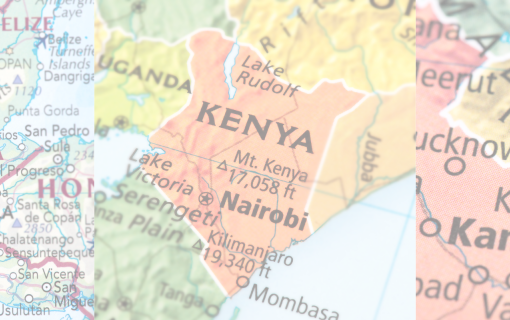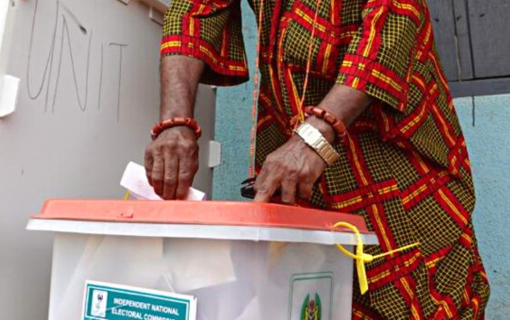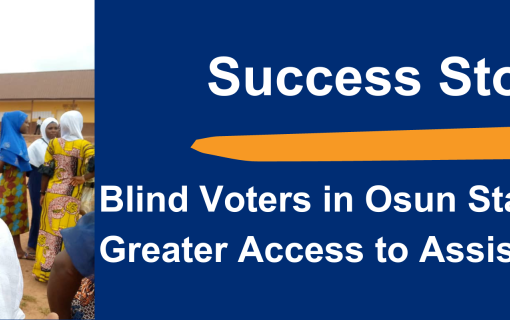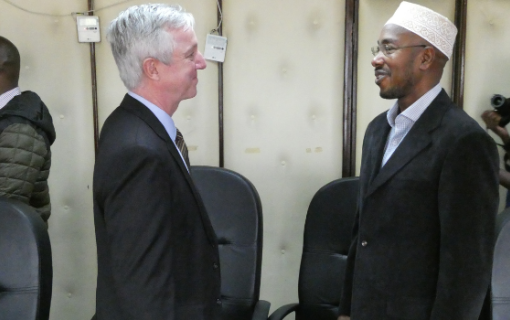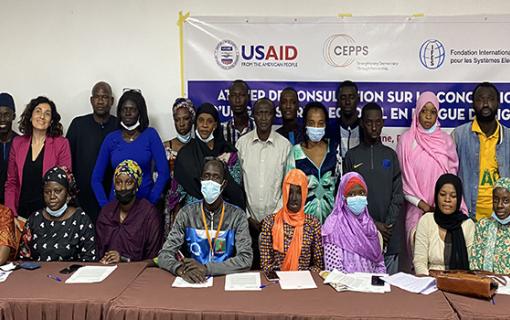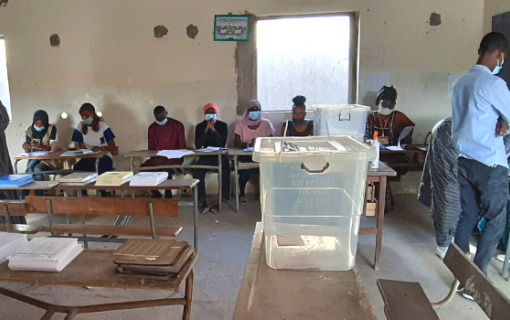
2017 Election in Kenya: President and CEO Diary
IFES President and CEO Bill Sweeney traveled to Kenya for the 2017 general elections. Through this feature, he shares his experiences from Kenya during this critical election:
Election Day
Polls opened at six in the morning today in Kenya, where citizens came to the polls to vote for president, county governors, members of the Senate, representatives to the National Assembly (including women county representatives to the National Assembly), and members of county assemblies.
Early reports from around the country indicated that most polling stations opened on time with polling staff and materials in place. The biometric voter identification technology employed by the Independent Electoral and Boundaries Commission (IEBC) is also reportedly working well. At his first press conference today, IEBC Chair Wafula Chebukati said that Kenya was on the path toward a credible, free and fair election, a sentiment echoed by media commentary.
The International Foundation for Electoral Systems (IFES) is not an observer. The IFES team is dispersed throughout our Kenya office, the IEBC offices, and the National Tally Center at Bomas. International monitoring missions include the Carter Center, European Union Election Observation Mission, the National Democratic Institute, as well as four different African regional organizations and Kenyan civil society groups. The religious communities are fielding 12,000 observers. IFES has briefed most of these groups in the lead up to the vote these last few weeks.
 IFES President and CEO Bill Sweeney meets with former Secretary of State John Kerry, the co-chair of the Carter Center’s observation mission in Kenya, at the IEBC’s National Tally Center at Bomas.
IFES President and CEO Bill Sweeney meets with former Secretary of State John Kerry, the co-chair of the Carter Center’s observation mission in Kenya, at the IEBC’s National Tally Center at Bomas.At midday, voters were steadily heading to the polls and the process was working. Thinking back to the lead up to the election, I’m struck by how much progress IFES programs have achieved over the last six months – it is great to see firsthand. Nonetheless, there are still challenges ahead. With all the progress made, it seems like quite some time since demonstrations lead to the removal of the IEBC commissioners a year ago. By the time the new IEBC commissioners took office, there was only seven months left until these elections.
Given the short time the new IEBC had to organize the August polls, IFES emerged as a valuable partner in preparing for the vote. Through IFES Kenya’s efforts, poll worker training manuals were written and cascade training techniques were used to prepare approximately 380,000 Kenyans staffing 40,883 polling stations. IFES also provided some of the most experienced African information communication and technology professionals to the IEBC for an election where technology is critical. Furthermore, voter education initiatives, particularly directed at young voters (46 percent of registered voters are between 19 and 29), women, and people with disabilities have seen positive results.
Given the violence that has characterized past elections in Kenya, a key component of IFES programming has been focused on the prevention and mitigation of election violence. We have panels of community leaders organized to immediately respond to violence. But, we hope that their work is not needed in the following days.
The next challenge to this election will likely not emerge until the count starts to come in. Both incumbent President Uhuru Kenyatta and his major competitor Raila Odinga are prepared to announce their respective victories, with all data suggesting a close result. How Kenyans respond to the eventual results is what we are all waiting to see.
The Day After: The IEBC Address Technical Challenges
Around 4:00 p.m. on Election Day, I returned to polling stations at the St. George and the Kilimani Primary schools in Nairobi where people had been lining up at 4:30 a.m. for the 6:00 a.m. open. The uniform expectation was that the polling stations would see better than 60 percent turnout by the end of the day. All of these polling stations had been without incident: the biometric voter identification worked well and paper back up was available for those who failed fingerprint identification.
Voters were still in line at 4:00 p.m., but the lines were much shorter than in the morning. Many people said that they decided the afternoon lines would be shorter – an hour or so compared to four hours in the morning. The commitment to the opportunity to choose their leaders and future was inspiring.
I noticed the presence of parents with small children during the afternoon. Parents never put their children at risk. By the afternoon, the police and security personnel were clearly bored. In the morning, the director of security at the St. George school laughed with me about his assignment. He said this neighborhood was not violent and his team would be standing around all day, although he appreciated the need for a security team. The security forces were uniformed, carried automatic weapons, and were not intimidating or threatening to voters or the democratic process.
Polls officially closed at 5:00 p.m. and late in the afternoon IEBC Chair Wafula Chebukati announced that if polls had not opened on time in the morning, then extra time had to be added at the end of the day so voters had the same amount of time to vote at each polling station, creating a staggered polling closing across the country. Many Kenyans reportedly voted late in the day. Best global practice is that everyone in line at closing time has the right to vote. The chairman’s appropriate decision meant later closing times and reporting of results.
On the morning of Election Day, everyone was paying attention to whether polling stations would open on time equipped with materials. The answer was a definitive yes. In fact, most Kenyan poll workers usually arrive the night before and sleep at their stations because people begin queuing at four in the morning. Next, we all looked to the operation of Kenya Integrated Elections Management System (KIEMS), a component of which is biometric voter identification (for more on KIEMS, please see “How does the Kenya Integrated Elections Management System work?” in IFES’ FAQs). Again, the answer was yes, as the system properly identified citizens across the country.
Along with this robust biometric technology in Kenya, the paper voter registration document includes a voter’s color photograph, which is a far more robust form of identification than any procedure in the United States or many Western democracies. In my prior life, I invested a fair amount of time understanding fingerprint identification systems and I can say that the Kenyan system worked pretty well.
The next challenge was the results transmission process. KIEMS was to report provisional results per polling station, which would also be available to the media, civil society, and party agents. The major concern was that about one-third of the country might not have 3G cellular coverage. It appeared the KIEMS data was being transmitted to the National Tally Center and being received, but the transmission couldn’t progress through the server to be received and displayed. As this system paralysis was being resolved, the entire country started asking questions about the count, the technology and the IEBC.
In my presentations to the various monitoring missions, I called this the “Nairobi digital highway traffic jam.” At some point, thousands of digital packets of information simply clogged the system. Over the evening, it became clear that thousands of polling stations, party agents, civil society and other users overwhelmed the cellular systems and the IEBC’s backend systems, which were supposed to absorb all this incoming data.
One tablet was used for two different key technological solutions implemented by the IEBC for this election. First, was the biometric voter identification component, which was linked to the national voter registry, and that process worked well. Next, the tablets were to transmit provisional results from each polling station. From the beginning, I feared this process was problematic. First, it depended on reliable service by the cellular carriers. Two-thirds of Kenya is covered by one of three carriers, but lack of coverage is a regular source of complaints. Second, it depended on adequate server capacity to receive all this incoming data. Third, the court had ruled that the results from the polling station were considered final results, which meant any clerical error or malfeasance would not be reviewed prior to being accepted at the National Tally Center. In past elections, vote totals had been manipulated as returns moved through the levels of consolidation.
Technology selections of hardware, software and service are always challenging for election commissions. Sometimes the issue is identifying past problem that need to be addressed and then building a specific solution for that problem. In 2017, the IEBC faced several challenges. Procurement decisions were postponed until January, when new commissioners were sworn in. Losing vendors challenged the IEBC’s selection decisions in court. Political parties also contested selections in court or the media by alleging corruption. One result was a sole source selection of Safran, a provider of equipment for the last election. While the equipment arrived in time for some testing and training, it became clear on election night that the integrated solution involving multiple applications from different suppliers had some glitches, which were preventing the returns from being received and displayed. (For more on the procurement challenges facing the IEBC, please see “What major challenges has the Independent Electoral and Boundaries Commission encountered regarding procurements of electoral materials?” in IFES’ FAQs).
Over the rest of election night and into the Wednesday morning, the IEBC made the decision to continue to post whatever results made it through the system. There was a series of meetings and debate on this issue, which consumed a huge amount of time. There was also a constant push by vendors to solve the problems so the provisional results could be posted. Vendors in this space are almost always suspect. There is a culture clash between private sector profit motive and public servants trying to solve a problem and serve the public good within a usually restrained budget and timeframe.
Despite these technology challenges, international observation missions have expressed confidence in the electoral process. "Candidates and their supporters must accept that not winning is a natural part of a democratic competition," European Union observer mission head Marietje Schaake said, adding, "Any irregularities or challenges to the process and outcomes should be addressed through petitions and the courts." We all hope that parties, candidates, and citizens remain peaceful in their rhetoric and actions in the coming days as the results are finalized.
The Complexity of Election Administration in Kenya
Election administration is often about logistics. Simple items make a big difference. All polling centers were supposed to have two cardboard polling stations to protect the privacy of the vote. Some polling sites received only one cardboard station, which slowed down voting. Some polling station officers added school desks as stations to speed up the line. Others used cardboard to create screens between desks. Voters didn’t seem to object and most party agents respected voters’ privacy.
The Kriegler Commission report in the aftermath of the 2007 election noted some polling stations reported high rates of party agents assisting voters. There are legitimate reasons for assisted voting – often because illiteracy, age, or disability. There can also be corruption of the ballot by assisted party voting. Kenya changed its law so that a person can only assist one voter and this is noted in the polling station record except for when a voter requests help from the polling station manager. These rules were followed and marked a substantial improvement from previous elections.
One major concern was the number of ballots printed in excess of the number of voters registered per polling station. For the 2017 election, 20,818,000 ballots were printed in 416,360 ballot booklets of 50 numbered ballots – approximately one million more than the 19,611,423 Kenyans registered. Given the number of voters, only one million extra ballots should make it impossible to engage in widespread vote stuffing, particularly with each ballot numbered and hopefully accounted for in the presiding manager’s report. It was an issue of pressing concern pre-election, but there has been no mention so far post-election. The IEBC does have the responsibility for the quick retrieval of sensitive voting materials, like unused ballots. If there were problems, we will find out in the next two weeks.
It was impressive to witness the significant number of women who were polling officials and poll workers. Many times in the societies IFES works in, the first time a woman works outside of the home or does something in the public space is when they work for the election commission at the polls. Virtually every international observation group noted the impressive number of women as presiding and deputy presiding officers as well as poll workers. As Kenya elected three women governors, there is progress on advancing women’s rights but there is a long way to go to fulfilling constitutional requirements.
Kenyan elections are among the most expensive in the world and easily the most expensive on the continent. According to Kenya’s treasury, 49.9 billion shillings (USD 480 million) goes to the IEBC, with 43 billion shillings to hire personnel, procure election materials, and conduct voter education. An additional four billion shillings were allocated to enhance security in hotspot counties and borders areas. Additionally, the judiciary, and intelligence agencies receive millions in direct and indirect funding. All told, this election was estimated to cost around one billion dollars.
This high cost raises a number of issues. Is this type of public investment in the election process sustainable over time? Public budgets are always under scrutiny due to competing priorities. Compared to what happened to the country in 2007, there has been a good return on the investment to make this level of expenditure – particularly in regard to biometric identification and security. Even as the culture of democracy takes hold and there becomes a system of public trust, can this level of expenditure continue? Second, societies often make public investments to overcome past mistakes. Kenyans have been correcting the issues in the conduct of the 2007 and 2013 elections by their investment in 2017. Demands for additional corrections and better technology mean more spending to correct those deficiencies. Third, what should the rest of the world conclude? Election administration is a global practice. Is Kenya an outlier? Is there public support in other democracies to make similar investments?
The murder of Chris Msando, who led the IEBC’s information technology department, cast a dark shadow over the conduct of the election. The police have not released the results of their investigation, allowing conspiracy theories to run rampant. For the IEBC professionals, there was a common resolve to “do this for Chris.” People worked through the nights to make the election worthy of his sacrifice. I was concerned that poll workers would be afraid and not show up on Election Day – I was delighted to be wrong. But there is also another message to election professionals around the world – this profession has dangers. We’ve seen this before in divided societies, particularly during political transitions and in war zones.
The IEBC Addresses Hacking Allegations
One central issue to the credibility of the election process is the reputation of the IEBC. The week of the election was a roller coaster for the IEBC. The day before and on Election Day, everyone was concerned about preparations and technology. Would polls open on time? Would the biometric identification work? Would the murder of Chris Msando scare off poll workers and voters? By Tuesday night, we saw the positive results of the IEBC’s hard work over the last six months.
By 10:00 p.m. on election night, it was clear that the KIEMS results transmission system had some issues. Numbers were not being posted in a timely fashion. While the IEBC huddled with Safran, the supplying vendor, to push for an explanation and a solution and conducted numerous meetings with political parties and other stakeholders, the IEBC decided not to communicate with the public. One could sense the erosion of public trust by midnight.
There was an intense discussion about whether to stop posting any results or allow the results to be posted as they came in. While the IEBC made a courageous decision to follow their process and continue to post results, it was contentious and, again, the lapse in posting continued to sap the confidence of all observers. There remained radio silence from the IEBC on Wednesday morning, in part because vendors had not provided an explanation or a solution.
Leading opposition candidate Raila Odinga and his National Super Alliance (NASA) then made the charge that the IEBC had been hacked. He claimed he had evidence from a log, which he made public as well as provided to the EU observer mission. In response to two questions during his press conference, IEBC Chairman Chebukati did not rule out the possibility of an intrusion. This statement stunned the political community watching the elections closely. Chairman Chebukati said they would investigate, but at the time many believed that the IEBC chairman was accepting the hacking charge made by NASA.
By noon on Thursday, the IEBC was in danger of losing its credibility with Kenyan and international observers. Odinga, however, overplayed his hand. He issued a public letter demanding to be named the winner. To his credit, the IEBC Chairman responded directly, explaining the process and highlighting a one million vote math error in Odinga’s letter.
By this time, it was also common knowledge among the observers and the political community that the computer log made public by Odinga to prove his hacking charge was from a Microsoft system while the IEBC software was Oracle. During an afternoon press conference, the IEBC CEO said the commission review proved that while there were attempts to penetrate the system, none were successful. The press who were shocked by the IEBC chairman’s earlier remarks were satisfied with the explanation – a charge was made, not denied outright, and then investigated.
Friday, August 11 – Announcement of Election Results
The IEBC had seven days to announce the next president of Kenya in accord with the election law and the constitution. Four years ago, in the 2013 elections, the IEBC announced the winner four days after polls closed. I always suspected the goal was to announce the winner as quickly as possible.
This time around, the vote tabulation process was a secure paper procedure, with the filing of 34A and 34B tallying forms. The deadline for the forms to be delivered to the IEBC in Nairobi was noon on Friday, August 11. The IEBC would only announce the final presidential election results after receiving vote tallies from all the 290 constituencies countrywide and collating them.
Unfortunately for the IEBC, forms slowly trickled into Nairobi and by close of business on Friday, two forms were still outstanding. The IEBC press conference originally scheduled at noon was postponed and irregular announcements were made during the day and into the evening.
From one perspective, the IEBC was following procedure and the law exactly. That was a good strategy anticipating a court challenge by the losing candidate. It may have been the correct decision given the anticipated inevitability of a legal challenge. However, the administrative lack of control was obvious. Every election official in the world knows the frustration of waiting for the last forms, precincts and polling stations to report – only most authorities try to avoid waiting in front of the public. The IEBC and Kenya were hostage to the letter of the law and two tallying forms.
President Kenyatta’s communications team had arrived at the National Tally Center in the morning in anticipation of a noon announcement. The president left his residence and went to his party’s headquarters at 5:00 p.m. The stage was set for a victory announcement before the party faithful. President Kenyatta then left his headquarters to go to the National Tally Center at around 9:00 or 10:00 p.m.
Finally, the national returning officer – IEBC Chairperson Chebukati – announced the results at the national level. He read the results from all constituencies for every single candidate on the ballot. It took almost an hour! A frustrated President Kenyatta walked onto the stage, but the IEBC chairman continued to drone on with the results. It was an amazing presentation.
As an experienced lawyer, IEBC Chairman Chebukati knew that if he didn’t follow the exact letter of the law and formal process, the entire procedure would be challenged in court. On the other hand, the process was so cumbersome that even the president of Kenya got frustrated and walked onto the stage. To the IEBC chairman’s credit, he followed the letter of the law even though it was an uncomfortable public performance.
Kenyans watched for almost an hour until President Kenyatta was announced the winner of the 2017 presidential election. The IEBC chairman presented the certificate of election at 10:16 pm.
For many, the election was now over. A million plus vote margin is exceptionally hard to challenge or overturn. The alternative was to accept Odinga and NASA’s challenge that the election had been “rigged” from the beginning of the election cycle. There had been regular legal interventions challenging procurements and policies.
As the nation waited for presidential results on Friday, the security situation in Nairobi was becoming visibly more tense. The police and military deployed large vehicles in anticipation of trouble. Rumors of visible command posts by assorted gangs were reported to IFES’ building security. Unlike 2007, where there were reports of “signals” to the street to protest, Odinga and his team never formally issued a call to action. The NASA leadership was disappointed and angry, walked out of the National Tally Center and made public statements but never enough to generate a national riot.
There were incidents between rioters and the police. By Saturday morning there were confirmed reports of 24 killed, including two children. Many observers felt the casualty rate was much higher and there were multiple reports of excessive force. President Kenyatta called on the police and military to avoid excessive force.
Malcolm X said it is far better to use “the ballot rather than the bullet” in deciding a nation’s destiny. Election violence is the collapse of a society’s efforts to make decisions where every vote is counted and every voice heard. IFES invested in rapid response to violence and peace building efforts in partnership with civil society and the religious communities of Kenya – preparing for the worst. IFES condemns all forms of violence – particularly in Kenya when it was used as a substitute for political protest.
Post-election Petitions in Kenya
By Katherine Ellena, IFES Senior Legal Specialist, Center for Applied Research and Learning
Odinga, announced on Wednesday, August 16, that he will file a petition with the Supreme Court regarding the presidential election. Once the petition is formally filed with the court (which must occur within seven days of the announcement of results according to Article 140(1) of the Constitution) and notice is served on the IEBC and any other respondents, the IEBC/respondents will have four days to respond (section 11(1) of the Supreme Court (Presidential Election Petition) Rules 2017 – hereafter “the Rules”). The grounds for filing are set out in section 8 of the Rules and are as follows: (a) the validity of the conduct of a presidential election; (b) the validity of the qualification of a President-elect; (c) the commission of an election offence as provided under the Election Offences Act (which includes offences related to the use of election technology); (d) the validity of the nomination of a presidential candidate; or (e) any other ground that the Court deems sufficient, provided such ground shall not be frivolous, vexatious or scandalous. The court will hold a pre-trial conference within eight days of the filing of the petition and then hearings will commence after that (section 14(1) of the Rules). A judgment must be made within 14 days of the petition being filed.
The IEBC has 48 hours from the date of the service to provide certified copies of the documents used to declare the results to the Supreme Court (section 12(2) of the Supreme Court Act 2011). The burden is on the petitioner to prove the case, and according to the jurisprudence, the standard of evidence is generally higher than the civil standard of balance of probabilities, but lower than the criminal standard of proof beyond a reasonable doubt. However, if the petitioner in a presidential election petition seeks to prove that the successful candidate did not garner a prescribed minimum number of votes, must prove such an allegation beyond a reasonable doubt. According to section 83 of the Elections Act, “No election shall be declared to be void by reason of non-compliance with any written law relating to that election if it appears that the election was conducted in accordance with the principles laid down in the Constitution and in that written law or that the non-compliance did not affect the result of the election.”
Election petitions regarding the parliamentary and country elections must be filed within 28 days of the declaration of results of the election (section 76 of the Elections Act), and must be resolved within six months of the date of filing of the petition (section 75(1) of the Elections Act).
Final Thoughts
The Kenyan election was a lesson in how the political process can literally paralyze a country. Election Day was Tuesday, August 8. People started leaving Nairobi for fear of election violence the week before the election. News reports documented crowded buses leaving Nairobi, significant fare increases and the fear of violence.
Traffic in Nairobi visibly decreased day by day leading to August 8. The number of shops – in shopping malls as well as street vendors – open for business decreased each day. Restaurants closed for lack of customers, staff and supplies. The “matatus” (privately-owned minibuses and the main means of getting around for local people) had vanished by Sunday, August 6, and did not begin to reappear until the Saturday after the election. The business pages of local newspapers were filled with stories of lower than usual economic activity around an election and lowered productivity for the country. The hotel staff – from the manager to the cleaning crew and the security guards – told guests they were sleeping in hotels rather than risking going home and not being able to return to work.
Election Day was Tuesday and the slowdown in economic activity was visible since the Sunday before the election. While Tuesday was a national holiday for the election, the reality was that the entire week was lost. People openly worried about their jobs and their future; employers worried about the safety of their workers and their facilities. It was startling to read government ministers’ proclamations ordering public servants back to work after the election.
One of the opposition’s responses to Odinga’s defeat was to call for a national strike to protest his loss. Most people ignored it – they had to get back to work.
In the Philippines in 2010, President Benigno Aquino III won the election by more than 60 percent of votes. I remember people telling me the next day that they were glad to have their country back.
Kenyans are only now hopefully beginning to return to normal order.
For more on these elections, see IFES’ FAQs on Elections in Kenya.
For more from Sweeney, please follow his Twitter account.
For more on IFES’ work in Kenya, please click here.






